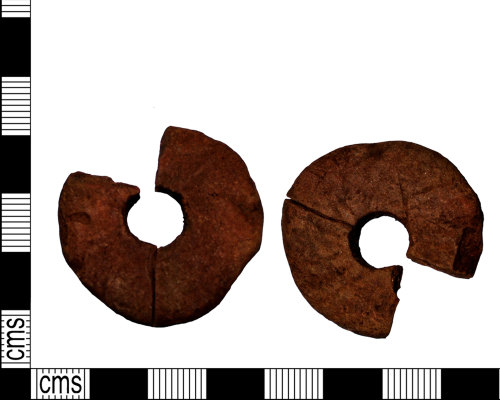
Rights Holder: The Portable Antiquities Scheme
CC License: ![]()
Image use policy
Our images can be used under a CC BY attribution licence (unless stated otherwise).
SPINDLE WHORL
Unique ID: LANCUM-B0BEB7
Object type certainty: Certain
Workflow
status: Published ![]()
An incomplete stone flat or discoidal spindle whorl, of Neolithic to Medieval dating (BC 3500 - AD 1900). Around 75% of the spindle whorl is present. Both faces of the spindle whorl are flat and undecorated; a circular perforation runs through the the centre, presumably for attachment to a wooden spindle (now missing). The spindle whorl is made from a fine-grained sandstone. The whorl is circular in plan and sub-rectangular in profile, with parallel faces. The central hole is sub circular in shape and has been drilled slightly off central, from both sides. The internal diameter of the hole measures 7mm wide. Both the upper and lower faces are flat. No traces of decoration are present on either the upper or lower faces. The diameter is 40mm and the weight 16.11g. Similar to WMID-CA394C, DEV-99C6F8 and CORN-900426 on the database.
Spindles were used to twist fabric fibres together to produce yarn. The whorls attached to the spindle acted as a weight to help to provide momentum whilst spinning and twisting the fibres together. This method of preparing yarn has been in use since prehistoric times and throughout the ages into the Roman, Medieval, Postmedieval and Modern periods. Margeson (1993, page 184)[1] has suggested that the weight of a spindle whorl is demonstrative of the thickness of yarn produced, with lighter spindle whorls (3 - 5 grams) being used for spinning cotton and the heavier ones (30 - 35 grams) for spinning wool. Since the weight of this spindle-whorl falls between these weight catagories it is remains unsure which material it would have been used with. Spindle whorls are difficult to date precisely out of their original context, since they were used through most historical and archaeological periods. Many of the later examples tend to be undecorated. Egan (1998, page 256)[2] has argued that there was an apparent lack of interest in developing decorative styles of spindle whorls during the Medieval period, compared to the decorative examples known from the Roman and Early Medieval periods. Although decorated examples are known of from Medieval and Post Medieval periods.
[1] Margeson S., 1993, Norwich Households: The Medieval and Post Medieval Finds from Norwich Survey Excavations 1971-1978; East Anglian Archaeology Report No. 58, 1993
[2] Egan, G., 1998, The Medieval Household Daily Living c.1150-c.1450; Medieval Finds from Excavations in London: 6; Museum of London
Subsequent actions
Subsequent action after recording: Returned to finder
Chronology
Broad period: UNKNOWN
Period from: NEOLITHIC
Period to: MODERN
Date from: Circa 3500 BC
Date to: Circa AD 1900
Dimensions and weight
Quantity: 1
Weight: 16.11 g
Diameter: 40 mm
Discovery dates
Date(s) of discovery: Wednesday 25th February 2015 - Wednesday 25th February 2015
Personal details
This information is restricted for your access level.
Materials and construction
Spatial metadata
Region: North West (European Region)County or Unitary authority: Cumbria (County)
District: South Lakeland (District)
Parish or ward: Kirkby Ireleth (Civil Parish)
Spatial coordinates
4 Figure: SD2383
Four figure Latitude: 54.23688627
Four figure longitude: -3.18289262
1:25K map: SD2383
1:10K map: SD28SW
Grid reference source: From finder
Unmasked grid reference accurate to a 10 metre square.
References cited
No references cited so far.
Similar objects

Find number: LANCUM-C2E196
Object type: WEIGHT
Broadperiod: MEDIEVAL
A cast lead spindle whorl, probably Medieval used for spinning wool. The weight is flattish and sub-circular, thicker in the centre and with …
Workflow: Awaiting validation![]()

Find number: LANCUM-C2F835
Object type: WEIGHT
Broadperiod: MEDIEVAL
Lead alloy disc probably dating Medieval to Post-medieval 1200 to 1600AD. The disc is unusually dcorated in the form of an irregular cross. I…
Workflow: Awaiting validation![]()

Find number: LANCUM-542F45
Object type: WEIGHT
Broadperiod: MEDIEVAL
Cast lead-alloy weight, probably a spindle whorl, dating from the medieval period, that is c. AD1200-1500. The wight is biconical in shape wi…
Workflow: Awaiting validation![]()


